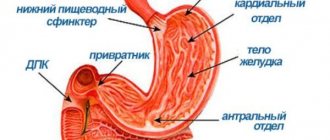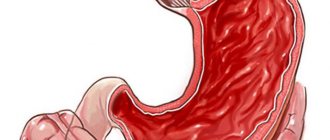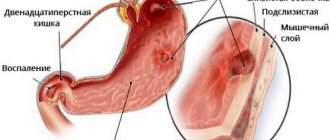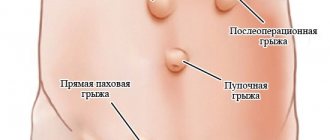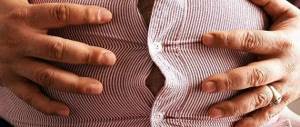General concepts
The term “atrophy” is commonly understood as the process of loss of function and structural changes in living tissue.
Subatrophic gastritis is characterized by the destruction of glands that secrete gastric secretions. When examined, dead areas of mucous membrane are found on the internal mucous membrane. There is a gradual thinning of the walls.
The prefix “sub” indicates that the disease is at an initial stage and the development of the pathology has not yet gone far. Modern experts no longer use the term “subatrophic” to refer to progressive inflammation, considering it obsolete.
Today the disease is called “atrophic gastritis”. In the international qualification system, the disease is assigned code K29.4.
ICD 10 code
The International Classification of Diseases defines subatrophic gastritis into the following codes:
- K29.1 (all types of acute gastritis);
- K29.3 (superficial chronic, which represents subatrophic arthritis);
- K29.4 (atrophied gastritis in chronic form);
- K29.5 (chronic gastritis in unspecified form).
The diagnosis of the disease is determined after the studies have been carried out, and in conclusion the doctor indicates the appropriate ICD code.
Causes
Atrophic gastritis is a polyetiological disease. In practice, in 90% of cases, malaise is a consequence of the presence of Helicobacter pylori in the body. Among other reasons, experts identify:
- hereditary predisposition,
- intoxication,
- long-term use of medications,
- uncontrolled drinking,
- nicotine abuse,
- malfunctions of the immune system,
- diseases of the digestive system.
Any of these factors can cause atrophic changes in the gastric mucosa.
At the initial stage, the disease is easily diagnosed and treatable . It is important to consult a specialist in a timely manner and not self-medicate.
Symptoms
The symptoms characteristic of the onset of the disease are similar to the clinical picture of other types of mucosal inflammation. The patient has:
- heaviness and pain in the epigastrium after a meal,
- feeling of bloating
- defecation disorder
- nausea, hiccups and vomiting,
- pain in the right hypochondrium,
- white coating on the tongue,
- loss of appetite,
- putrid odor from breath,
- increased sweating,
- drowsiness and lethargy,
- heart rhythm disturbances,
- hypotension,
- weight loss,
- pale skin.
Chronic gastritis, associated with the development of anemia, is characterized by numbness of the limbs and a general decrease in tone.
Forms of the disease
Atrophic gastritis exists in several types, differing in symptoms, diagnostic signs, localization and stage of development of the disease:
- Focal atrophic gastritis is characterized by tissue atrophy in certain areas of the mucosa.
- Superficial (catral) chronic gastritis affects the upper layer of the gastric mucosa.
- The antral form of gastritis is characterized by damage to the lower section, located at the junction of the stomach and intestines.
- Fundal gastritis destroys the mucous membrane of the fundus or body of the stomach.
- Multifocal or diffuse gastritis is characterized by a uniform distribution of affected areas. Atrophy affects several sections or the entire organ.
Superficial gastritis, depending on the number of dystrophically changed cells in relation to normal ones, is divided into weak, moderate and strongly expressed.
In case of exacerbation of the diffuse form of gastritis, it is recommended to refuse food for 2-3 days. To remove toxins, you need to drink mineralized water and herbal infusions.
Hyperplastic atrophic gastritis is characterized by tissue proliferation, which leads to the formation of polyps and cystic formations inside the stomach. For this form of gastritis, surgical intervention is indicated.
Acute atrophic gastritis is observed during a period of severe inflammation of the stomach walls. The pathology is accompanied by swelling of the mucous membrane. The patient needs urgent hospitalization. Intoxication of the body can lead to death.
Less common varieties
Expert opinion
Irina Vasilievna
Practicing gastroenterologist
Mixed hypertension combines several types of the disease. More often than others, a combination of erosive, hyperplastic and superficial gastritis is observed.
- Moderate hypertension is characterized by minor changes in the walls of the stomach, which can be recognized by histological examination.
- In the erosive form, mild damage to the mucous membrane is observed.
Autoimmune gastritis is a rare but dangerous disease , the occurrence of which is associated with a malfunction of the immune system.
With the development of pathology, gland cells are destroyed by antibodies. Due to intoxication, other systems and organs are affected. This type of hypertension is diagnosed in 10 out of one hundred patients.
Prevention
Prevention of gastritis includes actions aimed at eliminating provocative factors as much as possible:
- cessation of smoking and alcohol abuse;
- combating stress, especially chronic stress;
- ensuring proper nutrition;
- Periodic examination of elderly people by a gastroenterologist - at this age autoimmune gastritis is most likely.
Due to the prevalence of gastritis of Helicobacter etiology (statistically 90%), compliance with sanitary and hygienic standards should be a priority in the prevention strategy. Be sure to wash your hands thoroughly before eating.
It is unacceptable for two or more people to use dishes and cutlery at the same time: drinking from the same bottle, feeding a child with your own spoon. The Helicobacter bacterium is found in the intestines and mouth, so the practice of “biting off half” of a candy or chocolate bar in a child is unacceptable, even if the adult does not have gastritis.
Timely treatment of hormonal disorders and chronic infectious diseases will relieve not only the current illness, but also the danger of atrophic focal gastritis and the prospect of such serious diseases as cancer or stomach ulcers.
We recommend: Is it possible to eat oatmeal cookies if you have gastritis?
Diagnostics
At the initial stage, the clinical picture of gastritis of various etiologies is poorly distinguishable. To clarify the diagnosis, a comprehensive examination of the patient is carried out, including:
- fibrogastroduodenoscopy,
- fluoroscopy;
- histological tissue;
- intragastric pH-metry;
- Ultrasound of the digestive organs,
- probing,
- laboratory tests of stool, blood and urine.
FGDS is always prescribed, as it is the most effective method of examination.
Bacteria are detected during the examination of biopsies of the gastric mucosa. In other cases, the patient is prescribed an instant urease test with urea.
Cytological examination reveals Helicobacter pylori in gastric mucus. The analysis is also carried out to identify tumor processes at an early stage. To prescribe effective therapy for a disease caused by bacteria, studies are carried out to determine the sensitivity of the gastritis pathogen to antibiotics.
Treatment of subatrophic gastritis
Therapy is aimed at stopping infectious and inflammatory processes, normalizing acidity and gland secretion. In order to destroy the Helicobacter pylori bacterium, the patient is prescribed eradication treatment, including antibiotics. The first line includes three-component therapy lasting 10-14 days.
The patient is prescribed medications:
- "Amoxicycline"
- "Clarithromycin"
- "Nifuratel"
- "Josamycin".
If chronic gastritis is associated with high acidity , treatment is supplemented with PPIs (proton pump inhibitors), which have an antisecretory function. This group includes:
- "Omeprazole"
- "Esomeprazole"
- "Rabeprazole"
- "Pantoprazole."
In case of low acidity, PPI is replaced with bismuth preparations.
If therapy does not lead to an improvement in the patient's condition, move on to the second line. The patient is prescribed bismuth or PPI preparations (depending on the results of pH measurements).
Treatment is complemented by:
- "Metronidazole"
- "Tetracycline"
- "Furazolidone"
- "Rifaximin".
If two-stage eradication does not produce results, an additional analysis is carried out to determine the resistance of the pathogen to antibiotics.
Replacement therapy is prescribed to restore normal stomach function. The production of digestive secretions is stimulated by the drugs “Limonar”, “Pepsin”, “Pentagastrin”. To compensate for disturbances in the functioning of the pancreas, replacement therapy is supplemented with the drugs “Creon” and “Panzinorm”.
Patients with increased secretion of gastric juice are prescribed antacid drugs that have a coating effect. It could be Maalox, Gastal or Phosphalugel. To relieve pain, medications are used that relieve spasms of smooth muscles (Metacin, No-shpa, Atropine).
For symptoms of anemia and vitamin deficiency, the therapeutic regimen includes taking multivitamins and iron supplements, and injections of vitamin B12.
Therapy for autoimmune gastritis in case of a serious malfunction of the immune system includes taking glucocorticoid hormones.
Treatment is carried out in short courses. Prednisolone in a dosage of no more than 30 mg per day is prescribed to the patient after performing immune tests. If treatment is unsuccessful, repeating the course is not advisable. It should be noted that the combination and dosage of drugs used in the treatment of atrophic gastritis depends on the diagnosis and the chosen regimen. Unsystematic use of medications will cause a deterioration in the patient's condition . Only a gastroenterologist can make decisions about treatment.
Folk remedies
Herbal medicine in the treatment of gastritis not only helps to cope with the symptoms of the disease, but also helps detoxify the body. Rosehip infusion and chamomile decoction have a positive effect. They are recommended to be consumed before meals, 2-3 times a day, at least half a glass.
Other herbs are also successfully used in the treatment of gastritis, including:
- sage,
- peppermint,
- plantain,
- St. John's wort,
- marigold,
- sagebrush,
- eyebright,
- angelica rhizome.
They are used as part of herbal preparations or separately.
Allergy sufferers should approach taking herbs with caution. They can provoke a negative reaction from the body.
A mixture of aloe pulp and honey is used as an adjuvant in the treatment of gastritis. It has a healing effect on the mucous membrane. The components are combined in a ratio of 50 to 50. Take a teaspoon of the composition before meals.
Another beekeeping product, propolis, also has a wound-healing and disinfecting effect. It is consumed daily for a month, on an empty stomach before breakfast. Propolis (8 g) is washed down with warm tea with lemon balm.
Folk remedies
Folk remedies for subatrophic arthritis are quite effective in combination with complex therapy. Before using the chosen method, it is best to consult your doctor. The most popular means:
- A combination of herbs (chamomile, St. John's wort, wormwood, sage, mint, dill) in equal proportions. The resulting tincture is taken 2 tbsp. Spoons three times a day before meals;
- Freshly squeezed potato juice is effective for treating gastritis, as starch has pronounced healing properties. The finished product is taken daily in an amount of 30 ml on an empty stomach in the morning for 20 days;
- Drink freshly squeezed cabbage juice in the morning on an empty stomach. A single dosage is 30–50 ml;
- It is preferable to eat green apples for breakfast, as they contain a large amount of fiber and natural acid;
- Taking a medicinal solution with aloe juice and honey. The finished product is taken on an empty stomach twice a day before eating.
Currently reading: Which tea is better to choose for gastritis and how to drink it correctly
Diet
Treatment of atrophic gastritis necessarily includes diet. For this disease, patients are shown table 2 according to Pevzner. The following are excluded from the menu for this disease:
- fresh bread,
- baking,
- soups and porridges with milk,
- legumes,
- fatty dairy products,
- smoked meats,
- pickles and preserves,
- mushrooms,
- fresh onion,
- rutabaga,
- radish,
- marinades,
- fish and meat with high fat content,
- kvass,
- grape juice,
- dates,
- figs,
- gooseberry,
- currants
- millet,
- pearl barley, corn and barley grits.
Spicy seasonings and sauces, fried foods, and hard-boiled eggs are contraindicated. It is recommended to exclude chocolate confectionery, cream cakes, coffee, and strong tea.
On our website: What tests are taken if gastritis is suspected?
The Pevzner diet allows the use of:
- dried bread,
- biscuits,
- soups with a weak broth of vegetables, poultry and fish,
- cranberry juice,
- lean types of meat (rabbit, lamb, veal),
- boiled or steamed lean fish,
- fruit, berry and vegetable purees without additives,
- turkey and chicken meat,
- fermented milk products with minimal fat content,
- vegetable and butter,
- eggs in the form of an omelet, steamed or soft-boiled,
- beets,
- potatoes,
- zucchini,
- cauliflower,
- green peas, fresh or frozen,
- carrots,
- ripe tomatoes and cucumbers.
It is allowed to eat rice, oatmeal, semolina or buckwheat porridge with water. You can season dishes with dill and parsley, cinnamon, and vanilla.
It is better to add lemons or oranges to tea, sauces, and infusions. Allowed sweets include marshmallows, marshmallows, jam, honey, and jelly marmalade.
Sample menu for table No. 2
1st day
Breakfast: mashed potato tubers in water, steamed fish, mint tea. Snack: fruit jelly. Lunch: chicken broth with noodles, baked pumpkin, cranberry jelly. Afternoon snack: rosehip decoction. Dinner: cheesecakes, tea with lemon, a spoonful of honey.
2nd day
Breakfast: steamed omelet, cocoa, biscuits. Snack: rosehip decoction with honey. Lunch: mashed potato soup with chicken meatballs, zucchini casserole with minced turkey, dried apricot compote (without berries). Afternoon snack: baked apples. Dinner: cottage cheese seasoned with sour cream and honey, tea with mint and chamomile.
3rd day
Breakfast: sticky rice porridge, green tea with a slice of orange. Snack: raspberry jelly. Lunch: vegetable cauliflower soup seasoned with cream, minced chicken soufflé with stewed zucchini, compote. Afternoon snack: baked pumpkin with honey. Dinner: boiled potatoes, steamed fish, cocoa.
4th day
Breakfast: 2 eggs, lean ham, rose hip decoction. Snack: blueberry jelly. Lunch: pureed carrot soup with rice, steamed meatballs with buckwheat in white sauce, green tea. Afternoon snack: apples baked with honey. Dinner: baked chicken breast with zucchini puree, cocoa.
5th day
Breakfast: boiled diet sausages, semolina pudding, tea. Snack: apple juice. Lunch: chicken broth, cauliflower and zucchini puree with veal, tomato juice. Afternoon snack: toast with jam, tea. Dinner: baked buckwheat pancakes, pear jelly.
6th day
Breakfast: viscous buckwheat porridge, cocoa. Snack: blueberry jelly. Lunch: vegetable puree soup with chicken broth, turkey cutlets with potatoes, apple compote. Afternoon snack: green tea, marshmallows. Dinner: boiled tongue with zucchini puree, tomato juice without salt.
On our website: Symptoms of chronic atrophic gastritis and its treatment
7th day
Breakfast: oatmeal, egg, tea with rosehip. Snack: fruit juice. Lunch: vegetable soup with meatballs, baked turkey steak, jelly. Afternoon snack: chamomile tea with marmalade. Dinner: buckwheat, steamed cutlets, tea with lemon.
Before going to bed, it is recommended to drink a glass of yogurt or kefir. Berry fruit drinks and fresh juices will help replenish your diet with vitamins.
The role of proper nutrition and diets in the treatment of illness
For gastritis, diet and proper nutrition are very important components of treatment, without which it will be ineffective.
Proper nutrition in this case implies a gentle regime for the digestive organs and activates the secretion of glands. Products considered beneficial for gastritis:
- low-fat soups;
- eggs;
- stewed and pureed vegetables;
- lean boiled meat;
- porridge;
- fruit puree;
Unhealthy foods include fried and fatty foods (dairy products, fatty meats and fish), as well as pickled foods, raw vegetables and fruits, canned food, legumes, coffee, and sweets. Spicy and salty foods are also extremely undesirable. All these foods and dishes irritate the walls of the stomach, so you should avoid them.
Alcoholic drinks and smoking should be prohibited for people with gastritis.
During an exacerbation, it is necessary to follow a diet consisting of cereals, low-fat broths and soups. Food should be of uniform consistency. On the day when the patient suffered an attack, it is better to completely refuse food. This will reduce pain and relieve the gastrointestinal tract.
The period of following the diet after an exacerbation of the disease will last about half a month. At the end of this period, it is necessary to gradually include new foods in food.
Even after some time, it is advisable to eat dishes made from soft ingredients so that they contain vitamins (especially C, E and B), animal proteins, and microelements. This diet will promote remission.
Consequences
Subatrophic gastritis attacks the parietal cells, as a result of which the secretion of gastric juice decreases and less pepsinogen and gastrin-17 are produced.
A decrease in the number of enzymes leads to disruption of the digestion process and absorption of vitamin B12, the deficiency of which provokes anemia and disruption of the central nervous system.
At an early stage, complications are expressed in functional disorders of the biliary tract and intestines . Next, organic changes occur, against the background of which chronic diseases such as pancreatitis, cholecystitis, and enterocolitis develop.
Expert opinion
Irina Vasilievna
Practicing gastroenterologist
Violation of acidity creates conditions for the proliferation of bacteria. The risk of developing malignant neoplasms increases. Gastric bleeding is considered a dangerous complication of chronic gastritis. Pathology occurs against the background of high acidity of gastric juice. The higher this indicator, the higher the risk.
A decrease in the production of hydrochloric acid (achlorhydria) leads to digestive problems; the stomach does not absorb nutrients well. The consequence of this is vitamin deficiency, deterioration of the condition of hair, skin and nails. Due to a lack of vitamin C, bleeding gums develop. Atrophic gastritis can cause gastric ulcers. The antral form of the disease is dangerous due to the development of intestinal obstruction and duodenitis.
On our website: How to cure focal antral gastritis?

